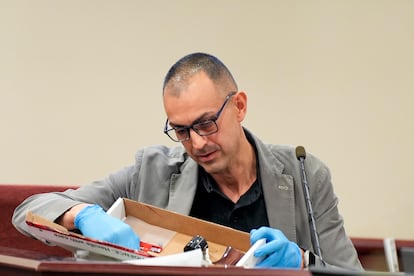At Alec Baldwin trial, gun manufacturer says the trigger had to be pulled to fire
In a victory for the prosecution on day two of the actor’s trial for involuntary manslaughter, Judge Marlowe Sommer allowed two redacted statements to be included in the evidence


It was a brief and to-the-point testimony. Alessandro Pietta, weapons manufacturer, traveled from Italy to defend the replica of the Colt revolver that has been at the center of controversy ever since a bullet killed cinematographer Halyna Hutchins on October 21, 2021. The expert was called in by the Prosecutor’s Office on the second day of the actor’s manslaughter trial so the courtroom could hear if the weapon had been subjected to a quality control process. “Of course,” Pietta assured with a dismissive gesture. Baldwin, 66, could spend up to 18 months behind bars if he is found guilty.
Pietta spoke with pride about the .45 caliber pistol he manufactured in 2017 for a gun show in the United States. He sent the replica of a weapon from the late 19th century inside a wooden box and without a fundamental part, the trigger, as it was a display piece. Years later, an Arizona gunsmith named Seth Kenney found it to be valuable and purchased it. In 2021, Kenney and his company would become the supplier of weapons and ammunition for Rust, a western starring Baldwin. Upon arriving on set, a trigger was added to the gun to make it more realistic-looking.
Ever since the time of the accident, Baldwin has maintained that he never pulled the trigger and merely cocked the gun. This claim led many to suspect that the gun fired due to a malfunctioning mechanism. Prosecutor Erlinda Johnson was quick to allude to this:
-"Is there any other way for the gun to be activated other than by pulling the trigger?" Johnson asked.
-”No, that is the only way,” Pietta replied.
The FBI conducted a dozen tests to see if it was possible for the revolver to open fire without pulling the trigger. In 11 attempts, the gun only went off this way. The last exam was more radical. The technicians hit it with a sledgehammer to see if it fired from the strong impact. The result was positive. But the blow destroyed the revolver.

Victory for the prosecution
The Prosecutor’s Office had a great day. Kari Morrissey and Erlinda Johnson, in charge of the prosecution, managed to get Judge Mary Marlowe Sommer to admit redactions to Baldwin’s interview with a detective following the shooting. The redacted portions involve a phone call with his wife, Hilaria, and a statement by the defendant in which he admits knowing that even blank ammunition can cause death.
Baldwin’s defense tried at all costs to prevent these two statements, which represent just a few moments in a sea of communications that the actor had after the incident, from forming part of the official record of the criminal trial. If this evidence is not integrated into the public version, it cannot be offered to the jury. In fact, the 16 members of the panel were outside the court while the parties debated.
The material in question is part of a personal conversation between Baldwin and his wife. The actor, after the incident, was trying to convince his family not to cancel plans to visit him in New Mexico. His children and his wife were meant to arrive the next day so they could be together while he worked on the western. “We’re going to have a great time,” Baldwin was heard saying, according to the records. One of their daughters even had a small role in the independent film. The actor argued that if they canceled, they would lose the money for the plane tickets.
“One person was injured and the other had been taken to hospital by helicopter. Meanwhile, Mr. Baldwin was worried because his wife was thinking about canceling the trip. He was not devastated, as the defense wants to make him out to be,” argued prosecutor Morrissey. The judge agreed that it was a fragment of interest. The defense rejected the idea, stating that the jury could misinterpret the phrase. “He was just trying to protect his family,” said one of the defense assistants.
The other fragment allowed by the judge is a statement by Baldwin to Detective Alexandria Hancock, of the New Mexico police. During the interrogation, the actor claimed that he had experience from other productions with various types of firearms, but that he did not own any. Baldwin also said that he knew that dummy ammunition could be lethal.

Defense attacks police investigation
The defense lawyers painted a poignant picture of the chaos that prevailed at the filming of the western. Live ammunition shared the same space as dummy ammo, which are almost identical to the naked eye. Lawyers for Baldwin spent the morning questioning the role of the police in the early hours of the investigation at the Bonanza Creek Ranch.
Attorney Alex Spiro went on the offensive against the prosecution’s witness, Marissa Poppell, one of the investigators from the Santa Fe Sheriff’s Office. Poppell was in charge of collecting evidence inside the church where the cinematographer was fatally wounded.
Spiro charged against the work of Poppell and her colleagues. The authorities found live ammunition on the set, including in the belt that another actor, Jensen Ackles, would use. Also in Baldwin’s shoulder bag. The lawyer accused Poppell of failing to follow leads that could clarify how real bullets had ended up on set.
“Tell the jury how long it took the police to request a search warrant for Seth Kenney’s [the weapons and ammunition supplier] warehouse,” Spiro asked.
”This was executed on November 30, a month and a week after the incident,” Poppell responded.
In two hours of examining the witness, Spiro attempted to cast a shadow of suspicion on Kenney. He, however, stated under oath at the trial of armorer Hannah Gutierrez-Reed that he did not deliver a single real bullet to the production. Poppell reported on Thursday that neither she nor her colleagues found a single live .45 caliber bullet in the warehouse during the search. Baldwin’s attorney speculated that Kenney destroyed evidence because police did not seize footage from surveillance cameras at the warehouse.
Spiro went even further, and assured that the police tried to conceal the fact that a “good Samaritan” showed up at the department to deliver a box of .45 caliber bullets. The subject stated that it was the same lot where the projectile that killed Hutchins came from. The statement caused surprise in the court until Morrisey used the microphone again.
The prosecutor then established that the subject who carried the alleged bullets was Troy Teske. “The man is a friend of Hannah Gutierrez-Reed’s father and the bullets were delivered in March 2024, after the sentencing of the armorer,” she explained. At that trial, it was determined that the real bullets were brought on set by the inexperienced Gutierrez-Reed and did not come from Kenney’s warehouse.
Sign up for our weekly newsletter to get more English-language news coverage from EL PAÍS USA Edition
Tu suscripción se está usando en otro dispositivo
¿Quieres añadir otro usuario a tu suscripción?
Si continúas leyendo en este dispositivo, no se podrá leer en el otro.
FlechaTu suscripción se está usando en otro dispositivo y solo puedes acceder a EL PAÍS desde un dispositivo a la vez.
Si quieres compartir tu cuenta, cambia tu suscripción a la modalidad Premium, así podrás añadir otro usuario. Cada uno accederá con su propia cuenta de email, lo que os permitirá personalizar vuestra experiencia en EL PAÍS.
¿Tienes una suscripción de empresa? Accede aquí para contratar más cuentas.
En el caso de no saber quién está usando tu cuenta, te recomendamos cambiar tu contraseña aquí.
Si decides continuar compartiendo tu cuenta, este mensaje se mostrará en tu dispositivo y en el de la otra persona que está usando tu cuenta de forma indefinida, afectando a tu experiencia de lectura. Puedes consultar aquí los términos y condiciones de la suscripción digital.
More information

Alec Baldwin gun trial: The ‘Rust’ tragedy seeks an ending
Archived In
Últimas noticias
Most viewed
- Reinhard Genzel, Nobel laureate in physics: ‘One-minute videos will never give you the truth’
- Oona Chaplin: ‘I told James Cameron that I was living in a treehouse and starting a permaculture project with a friend’
- Pablo Escobar’s hippos: A serious environmental problem, 40 years on
- Charles Dubouloz, mountaineering star, retires at 36 with a farewell tour inspired by Walter Bonatti
- Why we lost the habit of sleeping in two segments and how that changed our sense of time









































